Effects of Thermal Treatment on Microstructure and Wear Properties of Ni60/CeO2 Composite Coating 35CrMoV Steel by Laser Cladding
Abstract
1. Introduction
2. Materials and Experimental Procedures
2.1. Materials
2.2. Laser-Cladding Process
2.3. Thermal Treatment
2.4. Coating Characterization
3. Results and Discussion
3.1. Macroscopic Morphology of Cladding Layer
3.2. Microstructures Morphology of Cladding Layer
3.3. Solute Segregation Analysis

3.4. Phase Structure of Cladding Layer
3.5. Microhardness
3.6. Friction and Wear Properties
4. Conclusions
Author Contributions
Funding
Institutional Review Board Statement
Informed Consent Statement
Data Availability Statement
Conflicts of Interest
References
- Gao, Z.T.; Ren, H.B.; Yu, Y.; Guo, W.; Zhang, C.W.; Gao, Z.M. Effect of nano-WC content on microstructures and wear resistance of laser cladding Fe-based alloy coatings. Mater. Res. Express 2020, 7, 096515. [Google Scholar] [CrossRef]
- Jiang, X.; Zhou, Y.; Shi, C.; Mao, D. Effects of Ultrasonic-Aided Quenching on the Corrosion Resistance of GB 35CrMoV Steel in Seawater Environment. Metals 2018, 8, 104. [Google Scholar] [CrossRef]
- Jiao, F.; Zhao, D. Effect of laser cladding process parameters on the quality of cladding layer in 35CrMoV piston rod. In Proceedings of the 2018 9th International Conference on Civil Engineering, Materials and Machinery (ICCEMM 2018), Macau, China, 24–26 October 2018; pp. 73–77. [Google Scholar]
- Shi, C.; Li, F.; Wu, Y.; Mao, D. Effect of Ultrasonic Flexural Vibration on Solidification Structure and Mechanical Properties of Large-Size 35CrMoV Cast Ingot. Adv. Mater. Sci. Eng. 2019, 2019, 3421039. [Google Scholar] [CrossRef]
- Zhou, L.; Liu, Y.; Li, Z.; Zhu, L.; Li, Y.; Xiong, A. Microstructure and properties of Fe-Cr-Ni alloy coatings on T10 steel by laser cladding. Mater. Res. Express 2020, 7, 016513. [Google Scholar] [CrossRef]
- Gao, Z.T.; Ren, H.B.; Yu, Y.; Gao, Z.M.; Liu, E.Y.; Zhang, C.W. Effect of CeO2 on the microstructure and microhardensss of laser-cladded Ni60 on 35CrMoV alloys. Micron 2021, 150, 103146. [Google Scholar] [CrossRef] [PubMed]
- Yuan, W.Y.; Li, R.F.; Chen, Z.H.; Gu, J.Y.; Tian, Y.T. A comparative study on microstructure and properties of traditional laser cladding and high-speed laser cladding of Ni45 alloy coatings. Surf. Coat. Technol. 2021, 405, 126582. [Google Scholar] [CrossRef]
- Lou, D.Y.; Yang, S.; Mei, S.K.; Liu, Q.; Cheng, J.; Yang, Q.B.; Liu, D.; He, C.L. The Effect of Laser Scanning Speed on Microstructure and Performance of Cr3C2-NiCr Cermet Fabricated by in-situ Laser Cladding. Mater. Sci.-Medzg. 2021, 27, 167–174. [Google Scholar] [CrossRef]
- Shu, F.; Tian, Y.; Jiang, S.; Sui, S.; Zhang, X.; Zhao, H. Effect of rare earth oxide CeO2 on microstructure and surface properties of laser cladded CoFeCrNiSiB high-entropy alloy coatings. Mater. Res. Express 2019, 6, 106517. [Google Scholar] [CrossRef]
- Liu, H.; Fu, P.; Liu, H.; Cao, Y.; Sun, C.; Du, N.; Li, D. Effects of Rare Earth elements on microstructure evolution and mechanical properties of 718H pre-hardened mold steel. J. Mater. Sci. Technol. 2020, 50, 245–256. [Google Scholar] [CrossRef]
- Gao, Z.T.; Ren, H.B.; Geng, H.M.; Yu, Y.; Gao, Z.M.; Zhang, C.W. Effect of CeO2 on Microstructure and Wear Property of Laser Cladding Ni-Based Coatings Fabricated on 35CrMoV Steel. J. Mater. Eng. Perform 2022. [Google Scholar] [CrossRef]
- Masaylo, D.V.; Orlov, A.V.; Igoshin, S.D. Effect of Heat Treatment on the Structure and Phase Composition of a High-Temperature Nickel Alloy Obtained by Laser Cladding. Met. Sci. Heat Treat. 2019, 60, 728–733. [Google Scholar] [CrossRef]
- Durge, G.; Chandak, A.; Jaiswal, A.K.; Kiran KU, V.; Sunil, B.R.; Dumpala, R. Effect of heat treatment on the hardness and wear characteristics of NiCrBSi laser clad deposited on AISI410 stainless steel. Mater. Res. Express 2019, 6, 086524. [Google Scholar] [CrossRef]
- Lu, X.L.; Liu, X.B.; Yu, P.C.; Zhai, Y.J.; Qiao, S.J.; Wang, M.D.; Wang, Y.G.; Chen, Y. Effects of heat treatment on microstructure and mechanical properties of Ni60/h-BN self-lubricating anti-wear composite coatings on 304 stainless steel by laser cladding. Appl. Surf. Sci. 2015, 355, 350–358. [Google Scholar] [CrossRef]
- Guo, W.; Zhang, L.; Xu, C.; Chai, R.; Gao, Z.; Kogo, B.; Chizari, M.; Zhang, C.; Wang, B. Study on the wear resistance of laser cladding iron-base alloy by heat treatment. Mater. Res. Express 2019, 6, 026572. [Google Scholar] [CrossRef]
- Sun, J.; Ji, K.; Jiang, C.W.; Zhang, Y.C. Influence of Various Heat Treatment Stages on Evolution of Microstructure and Grain in H407 Steel. Met. Mater. Int. 2016, 22, 872–879. [Google Scholar] [CrossRef]
- Slater, C.; Mandal, A.; Davis, C. The Influence of Segregation of Mn on the Recrystallization Behavior of C-Mn Steels. Metall. Mater. Trans. B 2019, 50, 1627–1636. [Google Scholar] [CrossRef]
- Ren, Z.; Zhang, X.; Zhu, X.R.; Cheng, J.G.; Liao, F.K.; Xu, G.H.; Xu, Y.; Zhao, B.R. Uniform Heat Treatment of Direct Chill Continuous Casting Al-Si/Al-Mn Clad Slab. Rare Met. Mater. Eng. 2014, 43, 986–989. [Google Scholar]
- Chen, L.Y.; Zhao, Y.; Guan, C.; Yu, T.B. Effects of CeO2 addition on microstructure and properties of ceramics reinforced Fe-based coatings by laser cladding. Int. J. Adv. Manuf. Technol. 2021, 115, 2581–2593. [Google Scholar] [CrossRef]
- Perez, I.; Enriquez Carrejo, J.L.; Sosa, V.; Gamboa Perera, F.; Farias Mancillas, J.R.; Elizalde Galindo, J.T.; Rodriguez Rodriguez, C.I. Evidence for structural transition in crystalline tantalum pentoxide films grown by RF magnetron sputtering. J. Alloys Compd. 2017, 712, 303–310. [Google Scholar] [CrossRef]
- Wang, Q.; Ashraf, M.A. Investigation of the effect of nano-SiC on the hardness and wear resistance of Ni-SiC nanocomposite coatings. Funct. Mater. 2019, 26, 556–560. [Google Scholar]
- Pawar, S.; Jha, A.K.; Mukhopadhyay, G. Effect of different carbides on the wear resistance of Fe-based hardfacing alloys. Int. J. Refract. Met. H 2019, 78, 288–295. [Google Scholar] [CrossRef]
- Wang, S.; Zheng, Z.B.; Zheng, K.H.; Long, J.; Wang, J.; Ren, Y.Y.; Li, Y.M. High temperature oxidation behavior of heat resistant steel with rare earth element Ce. Mater. Res. Express 2020, 7, 016571. [Google Scholar] [CrossRef]
- Luo, X.S.; Li, J.; Jin, Y.L.; Hu, C.P.; Jia, D.; Zhan, S.P.; Yu, Y.; Hua, M.; Duan, H.T. Heat Treatment Influence on Tribological Properties of AlCoCrCuFeNi High-Entropy Alloy in Hydrogen Peroxide-Solution. Met. Mater. Int. 2020, 26, 1286–1294. [Google Scholar] [CrossRef]
- Gao, Z.T.; Geng, H.M.; Qiao, Z.H.; Sun, B.; Gao, Z.M.; Zhang, C.W. In situ TiBX/TiXNiY/TiC reinforced Ni60 composites by laser cladding and its effect on the tribological properties. CERAM. INT 2022. [Google Scholar] [CrossRef]
- Cui, B.; Zhao, W.; Zuo, R.; Zhang, L.; Cheng, Z.; Jiu, Y.; Qin, J.; Fu, Y.; Xu, D. Effect of rare earth alloy addition on the microstructure and abrasion resistance of brazed diamonds with Cu-Sn-Ti filler metal. Diam. Relat. Mater. 2022, 126, 109110. [Google Scholar] [CrossRef]

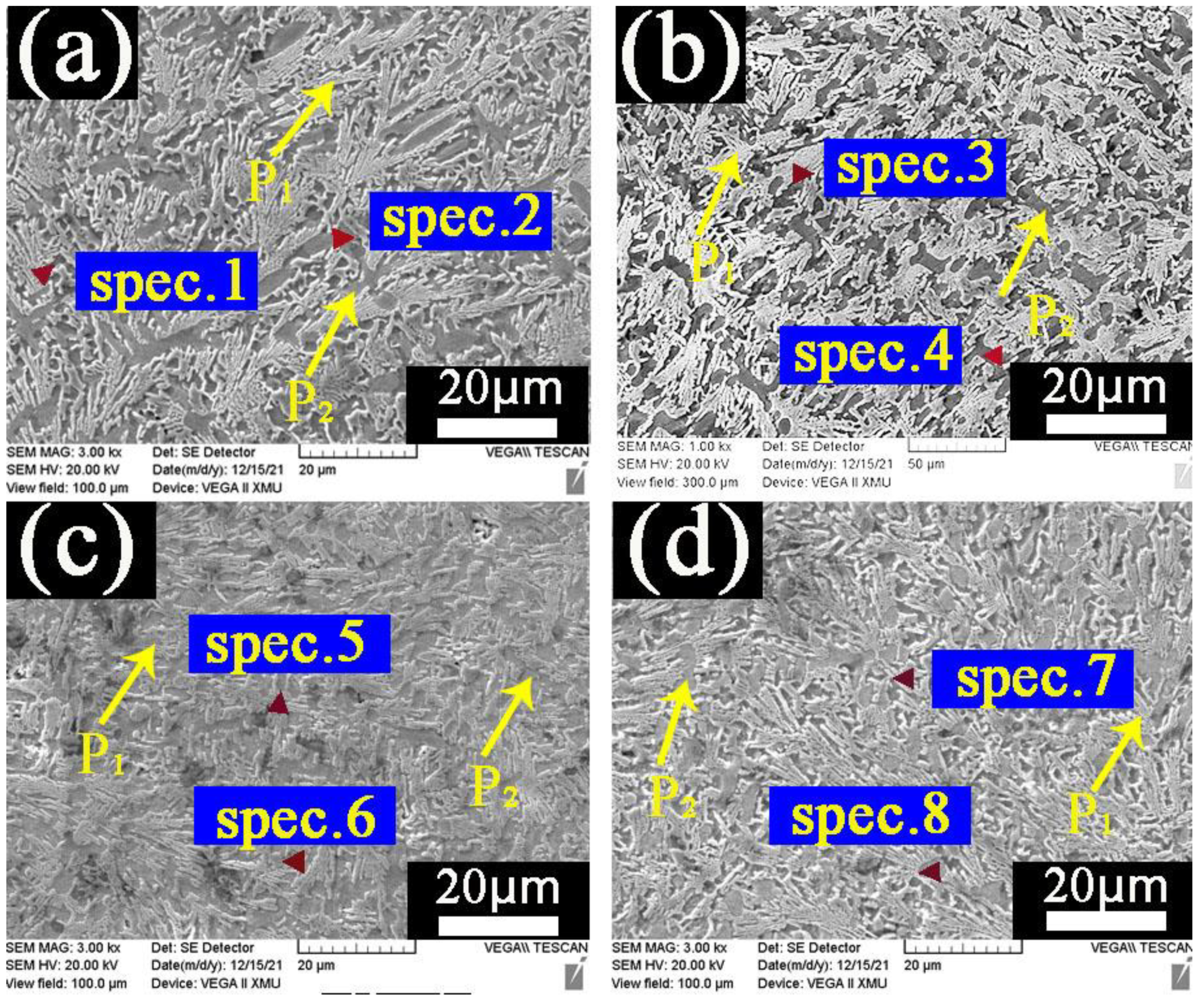
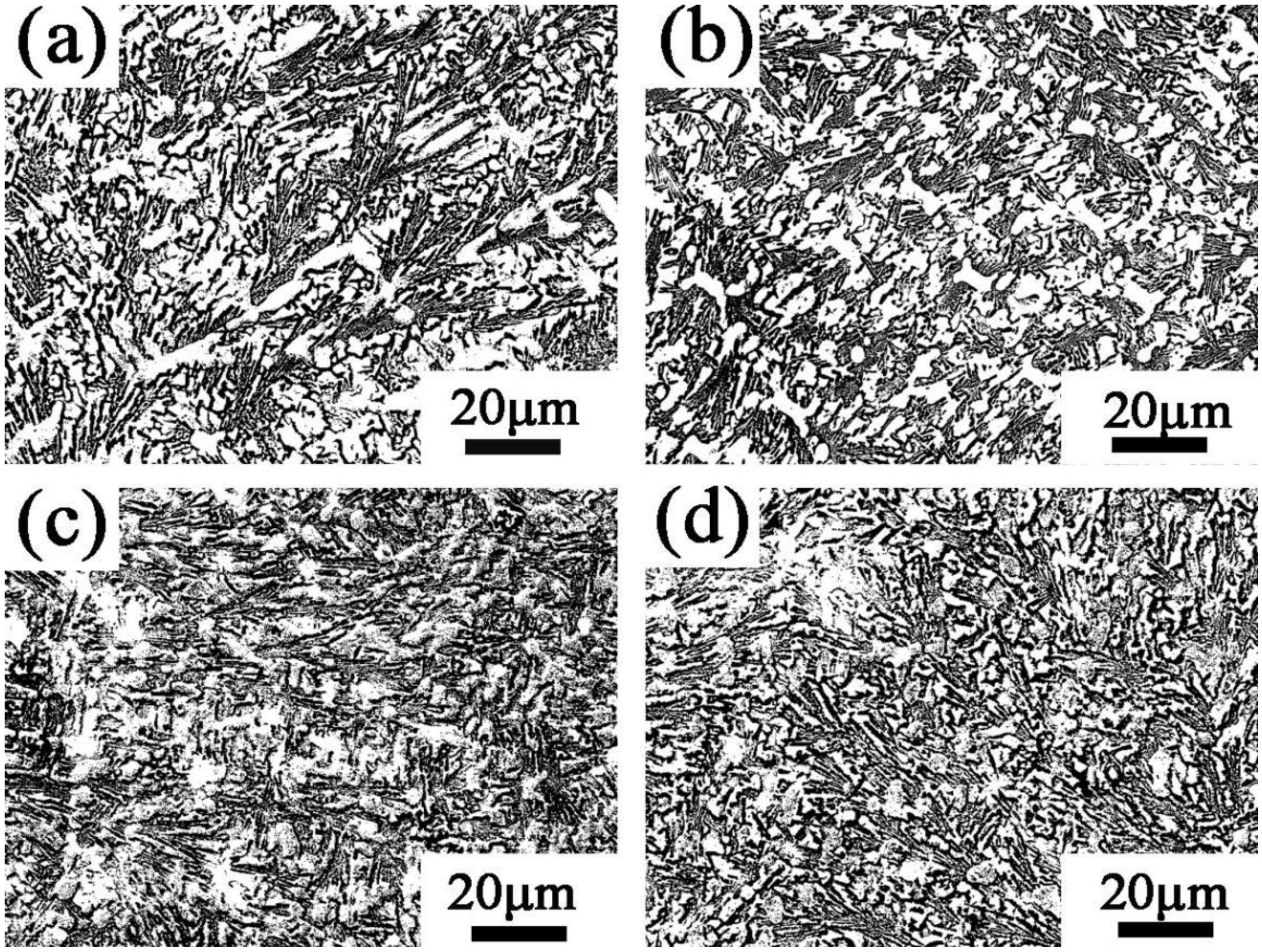

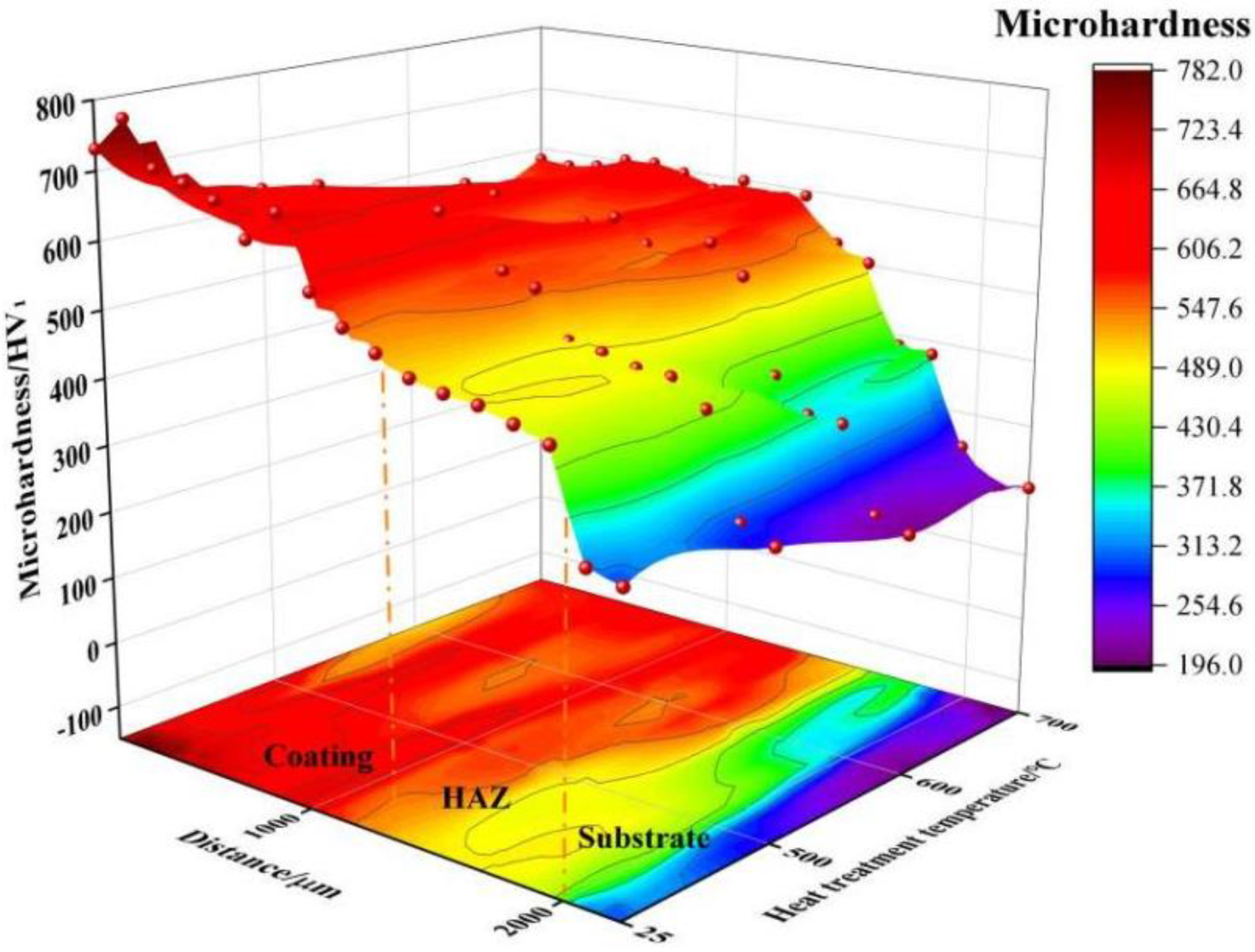
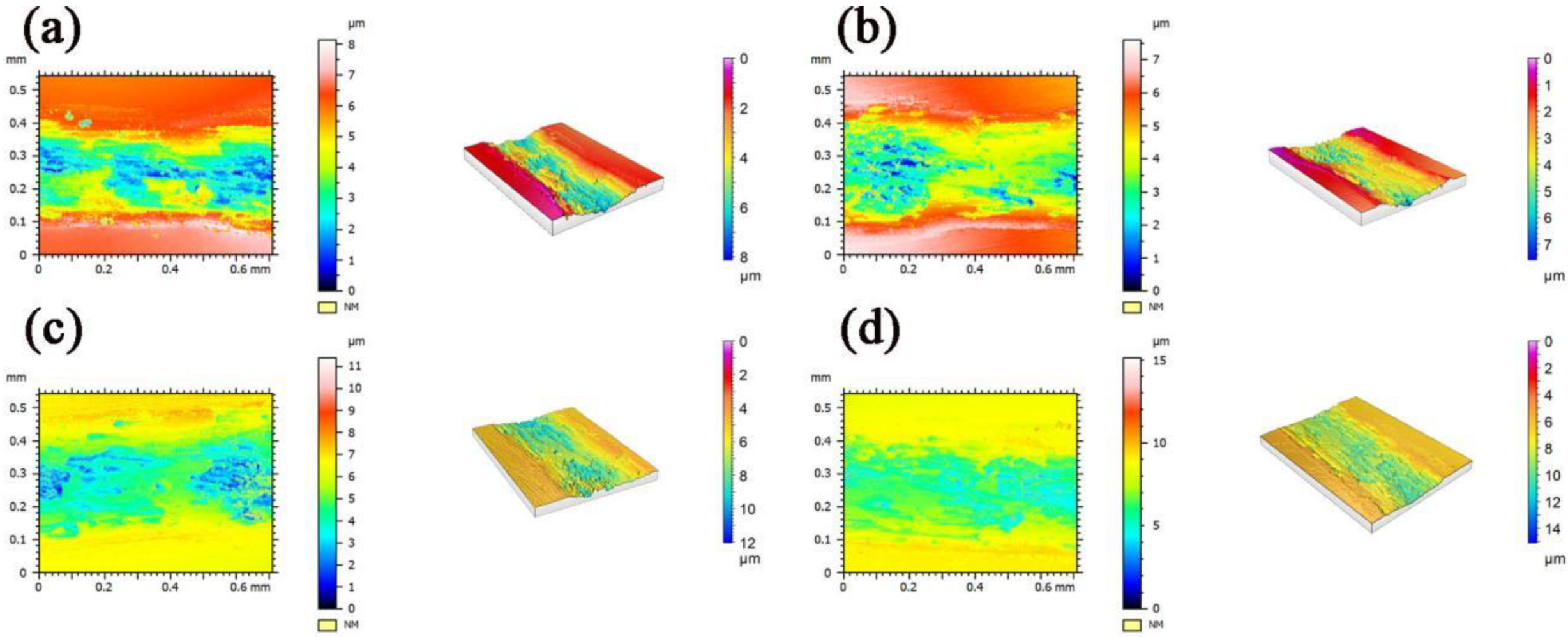

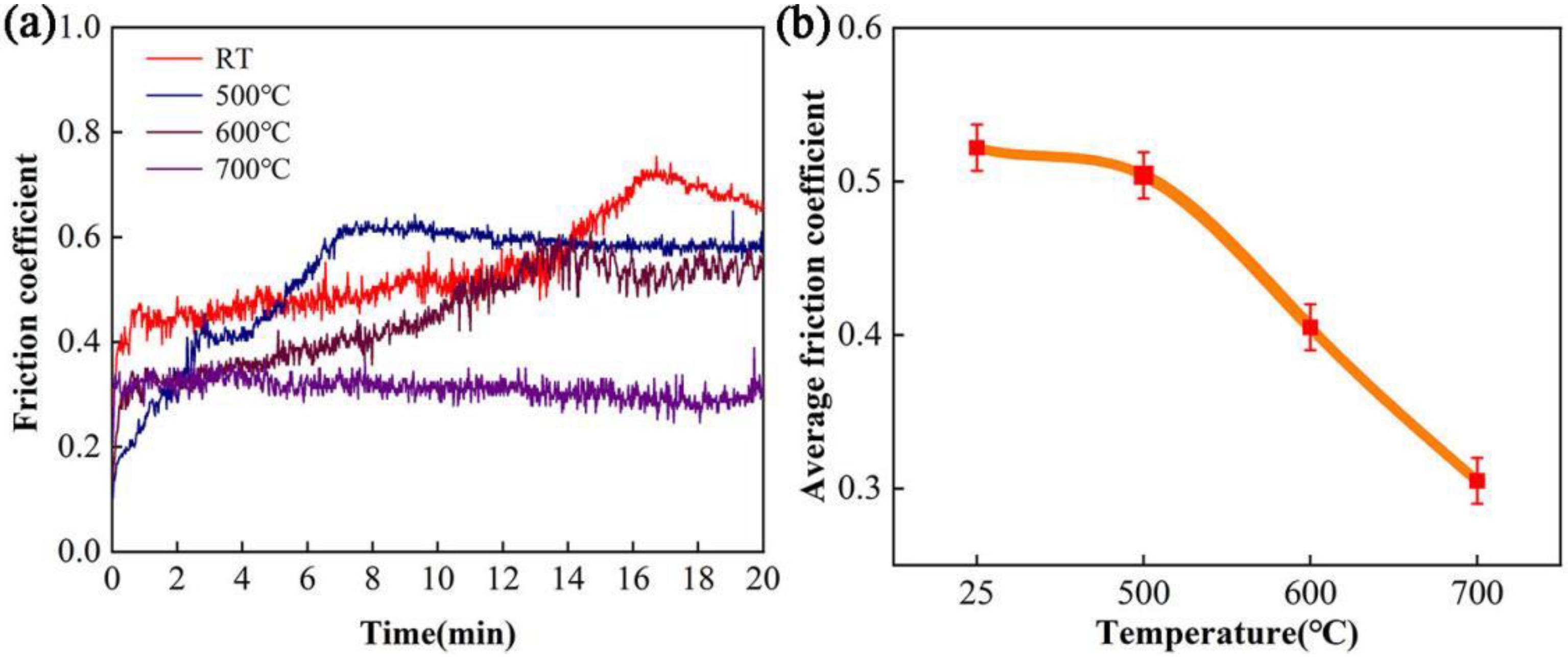
| Parameters | Value |
|---|---|
| Power | 3000 w |
| spot sizes | 15 mm × 3 mm |
| Scanning speed | 120 mm/min |
| Overlap ratio | 0.4 |
| Gas flow rate of argon | 15 L/min |
| The wavelength | 1080 nm |
| Content/wt.% | |||||||||
|---|---|---|---|---|---|---|---|---|---|
| C | B | Si | Cr | Fe | Ni | Ce | O | ||
| 25 °C | Spec.1 | 9.73 | 2.85 | 1.34 | 24.35 | 33.86 | 27.67 | 0.16 | 0.1 |
| Spec.2 | 2.32 | — | 3.09 | 8.99 | 38.14 | 47.77 | 0.14 | 0.09. | |
| 500 °C | Spec.3 | 15.6 | 1.56 | 0.77 | 28.15 | 27.57 | 27.91 | 0.12 | 0.06 |
| Spec.4 | 6.58 | — | 1.63 | 18.82 | 41.59 | 37.65 | 0.1 | 0.05 | |
| 600 °C | Spec.5 | 2.87 | 1.25 | 2.38 | 11.86 | 39.65 | 41.79 | 0.12 | 0.1 |
| Spec.6 | 2.07 | — | 3.12 | 9.08 | 40.66 | 47.23 | 0.17 | 0.04 | |
| 700 °C | Spec.7 | 1.02 | 0.16 | 2.29 | 11.37 | 40.66 | 44.82 | 0.21 | 0.16 |
| Spec.8 | 3.67 | — | 2.86 | 7.04 | 39.58 | 51.69 | 0.27 | 0.12 | |
| 25 °C | 500 °C | 600 °C | 700 °C | |
|---|---|---|---|---|
| γ + Cr2Ni3 | 0.57 | 0.55 | 0.46 | 0.36 |
Publisher’s Note: MDPI stays neutral with regard to jurisdictional claims in published maps and institutional affiliations. |
© 2022 by the authors. Licensee MDPI, Basel, Switzerland. This article is an open access article distributed under the terms and conditions of the Creative Commons Attribution (CC BY) license (https://creativecommons.org/licenses/by/4.0/).
Share and Cite
Liu, J.; Li, X.; Bai, J.; Zhang, T.; Xu, Y.; Yu, Y. Effects of Thermal Treatment on Microstructure and Wear Properties of Ni60/CeO2 Composite Coating 35CrMoV Steel by Laser Cladding. Coatings 2022, 12, 1575. https://doi.org/10.3390/coatings12101575
Liu J, Li X, Bai J, Zhang T, Xu Y, Yu Y. Effects of Thermal Treatment on Microstructure and Wear Properties of Ni60/CeO2 Composite Coating 35CrMoV Steel by Laser Cladding. Coatings. 2022; 12(10):1575. https://doi.org/10.3390/coatings12101575
Chicago/Turabian StyleLiu, Jianbo, Xiaohui Li, Jing Bai, Tong Zhang, Yunhua Xu, and Yuan Yu. 2022. "Effects of Thermal Treatment on Microstructure and Wear Properties of Ni60/CeO2 Composite Coating 35CrMoV Steel by Laser Cladding" Coatings 12, no. 10: 1575. https://doi.org/10.3390/coatings12101575
APA StyleLiu, J., Li, X., Bai, J., Zhang, T., Xu, Y., & Yu, Y. (2022). Effects of Thermal Treatment on Microstructure and Wear Properties of Ni60/CeO2 Composite Coating 35CrMoV Steel by Laser Cladding. Coatings, 12(10), 1575. https://doi.org/10.3390/coatings12101575






